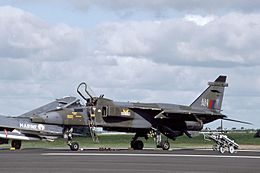1982 Royal Air Force Jaguar shootdown incident facts for kids

Jaguar GR1, identical to the aircraft lost
|
|
| Shootdown summary | |
|---|---|
| Date | 25 May 1982 |
| Summary | Shot down in friendly fire incident |
| Place | 35 miles NE of RAF Brüggen |
| Crew | 1 |
| Survivors | 1 |
| Aircraft type | SEPECAT Jaguar GR1 |
| Airline/user | Royal Air Force |
| Registration | XX963 |
| Flew from | RAF Brüggen |
On 25 May 1982, a Royal Air Force (RAF) SEPECAT Jaguar plane from 14 Squadron crashed. It happened about 35 miles from its base, RAF Brüggen in Germany. The plane was accidentally hit by a missile. This missile was fired by another RAF aircraft, a McDonnell Douglas Phantom. This event is known as a "friendly fire" incident. It means one's own side accidentally causes harm.
Contents
What Was Happening in 1982?
In 1982, the Royal Air Force (RAF) had many planes and people in West Germany. This group was called RAF Germany. Their main job was to provide combat aircraft. These planes helped protect Western Europe as part of NATO. RAF Germany had 14 different squadrons. These squadrons were spread across four air bases.
Types of Planes Used
Among these squadrons, five used the SEPECAT Jaguar. This was a single-seat plane. It was used for attacking targets and for looking at areas from the sky. Two other squadrons used the McDonnell Douglas Phantom. At that time, the Phantom was the RAF's main plane for defending against enemy aircraft.
How Did the Incident Happen?
On May 25, 1982, two Jaguar planes from 14 Squadron were flying back to their base. They had just finished a training flight. At the same time, another RAF base, RAF Wildenrath, was doing an air defence exercise. During this exercise, their Phantom planes would take off quickly. They would pretend to "intercept" other RAF planes. These Phantom planes usually carried training missiles.
The Training Flight Goes Wrong
Around 12:40 PM, a Phantom FGR2 plane took off. It was flown by Flt Lt Roy Lawrence and navigated by Flt Lt Alistair Inverarity. Their job was to "intercept" the two Jaguars. The Phantom crew found the Jaguars. The Jaguars did not try to avoid them. This was because they were low on fuel.
The Phantom crew then started their usual training steps. They prepared for a pretend attack. But when the pilot pressed the missile release button, a real AIM-9G Sidewinder missile launched. It hit Jaguar XX963. This Jaguar was flown by Flt Lt Steve Griggs.
The Crash and Ejection
The missile destroyed the back part of the Jaguar. The rest of the plane began spinning out of control. The Jaguar crashed in a farm field. Flt Lt Griggs was able to eject safely from the plane. He landed in a field about 35 miles from his base. The owner of the farm and his daughter helped him.
Why Did This Accident Happen?
After the accident, a special investigation was started. They wanted to find out what went wrong. The investigation found that several things led to the Phantom crew firing a live missile.
Problems Before Takeoff
The Phantom crew had missed the start of the air defence exercise. This meant their mission briefing was rushed. Also, the Phantom plane they were given had live missiles. This was because it was also ready for "Quick Reaction Alert" duty. This means it was prepared to take off quickly if there was a real threat.
Safety Switches and Mistakes
There was a main switch in the Phantom's cockpit. This switch was supposed to make live weapons safe. It should have been in the "safe" position. This would also show that the plane was armed. Another safety step was to pull a special switch in the back of the Phantom. This would also make the weapons safe. The navigator, Flt Lt Inverarity, said he had pulled this switch.
However, during the investigation, they found something important. It only took a small push on that switch to make the weapons active again. It was possible that the navigator accidentally hit the switch with his leg. This could have happened when the plane was flying with strong G-forces.
Finally, the people in charge at Wildenrath base did not know the Phantom was armed. If the air traffic controller had known, they would have told the crew to "check switches safe." This would have been an important safety reminder.
What Happened After the Accident?
Even though many things went wrong, the investigation blamed the Phantom crew. They were seen as forgetting that their plane had live weapons. Because of this, the two officers faced a special military hearing. They were found responsible for not being careful enough. They received a strong warning, which was the lightest possible punishment.
Another Ejection for Flt Lt Griggs
Five months after this accident, Flt Lt Steve Griggs had to eject from a plane again. On September 10, he was leading a training flight. His Jaguar plane caught fire in the main body. He ejected safely, and his plane crashed in a peat bog.
Images for kids



